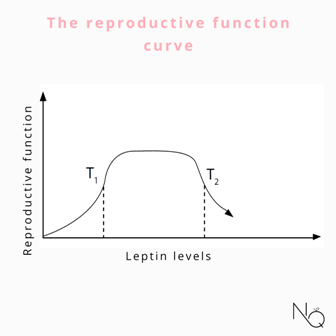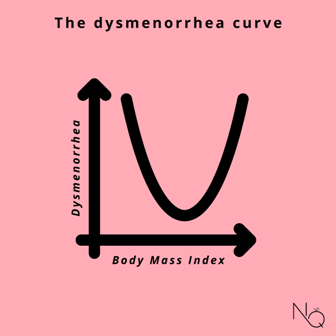Have you ever wondered if your "curves" are significant to your health?
Read on to see two curves that are s.o.s for the reproductive health of women and people with vaginas! The reproductive function curve (leptin)
Leptin is a hormone secreted by adipose tissue cells and has many different functions in the body. First of all, its name comes from the Greek word "leptos" meaning slim( leptos< leptin). Leptin has an anorexigenic effect, causing satiety, regulating appetite, and, thus, making us not want to eat. It got discovered in 1995, and the research around it has been significant. The higher our fat, the greater the concentrations of leptin in the blood, and vice versa. One of the actions of leptin is its involvement in the production axis of sex hormones, thus its relationship with reproduction.

So what does the leptin-reproductive function curve look like? The curved line is bell-shaped (see Figure 1), suggesting there is a minimum and a maximum leptin concentration between which reproductive function is maximal. It means that too low leptin values (i.e. very low fat, see left in the figure) or very high values (i.e. very high fat, see right in the figure) are usually associated with problems in the reproductive function of women and people with vaginas. It creates disturbances in the period, ovarian dysfunction, amenorrhea, and reduced fertility.
This relationship makes sense, as the state of nutrition is inextricably associated with reproductive function. "Nature" understands when food sources are insufficient and "blocks" reproduction preventing us from bearing offspring since their survival conditions will be unfavorable. The dysmenorrhea curve

Let's examine another curve, which is a bit similar, the dysmenorrhea-Body Mass Index (BMI) curve. Dysmenorrhea is the severe painful cramps that originate in the uterus and occur during menstruation (commonly referred to as "period cramps"). When there is no other underlying pathological condition, it is called primary dysmenorrhea (PD). Ju et al. studied 9688 female volunteers and showed the relationship between BMI and PD is u-shaped. It means that very low or very high body weight increases the likelihood of PD. Very low BMI or very high BMI are associated with PD. Which of your curves should trouble you?
Finally, the "curves" that should concern you are probably those of the abdomen. Waist circumference- measured in centimeters using a tape measure- is an indicator for estimating our visceral fat. Visceral fat is the fat that exists inside the abdomen and makes it difficult for the organs to function. It is also associated with developing diseases. The recommendation is that the waist circumference is below 88 cm.
In summary, body fat percentages and BMI significantly affect reproductive health, and it's good to be within limits to benefit your hormones, menstrual cycle, fertility, and overall reproductive function. I hope this article helped boost your NQ! Now you know how significant body fat is and that it can be our ally! If you are worried about your weight and fat, it will help you to have a somatometric assessment, where we will discuss the result and whether it would help to follow a specific diet to benefit your reproductive health.
Happy hormone days!




